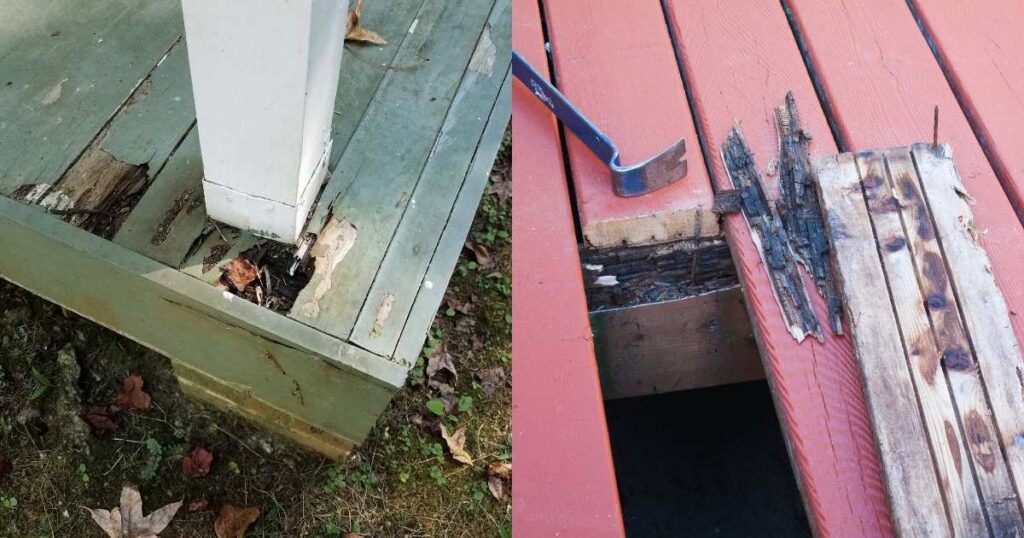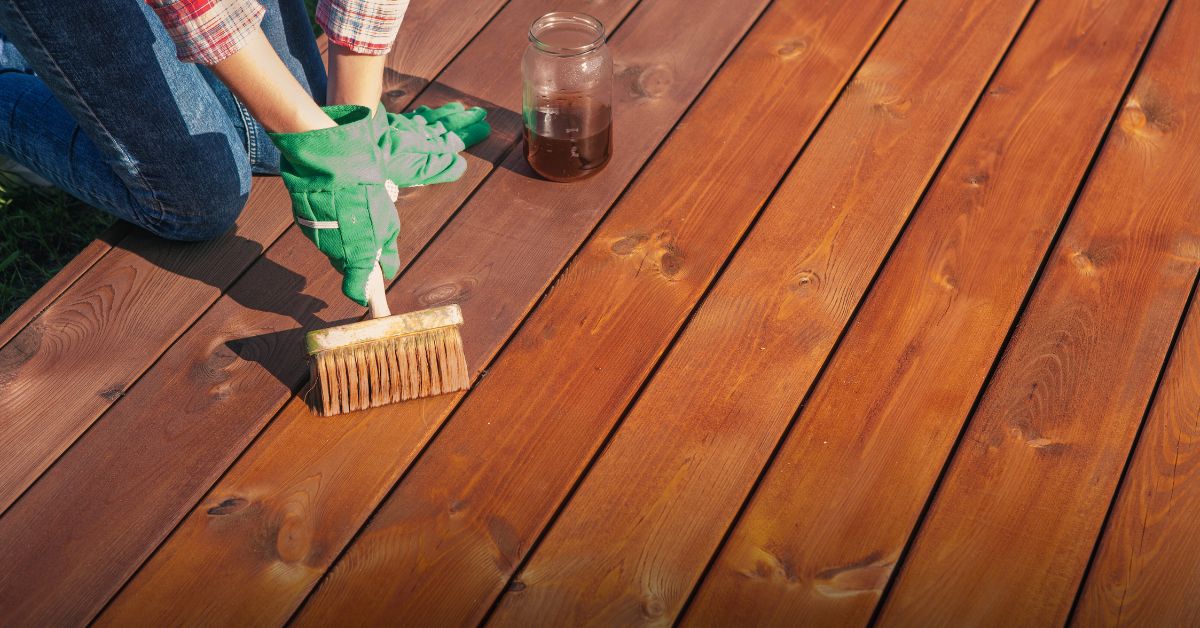A wooden deck adds warmth and charm to a home, but rain can slowly wear it down, causing cracks, rot, and mold. Without proper protection, moisture seeps into the wood, weakening its structure and shortening its lifespan. Imagine spending time and money on a beautiful deck, only to watch it fade, splinter, and decay because of water damage.
Rain doesn’t just make wood wet—it triggers a cycle of swelling, shrinking, and cracking. Over time, this weakens the boards, loosens screws, and creates the perfect breeding ground for mold and mildew. A poorly maintained deck can become slippery, unsafe, and an expensive headache to repair.
But preventing rain damage isn’t complicated. You can keep your deck strong and looking great for years with the right sealants, drainage solutions, and maintenance habits. In this guide, we’ll walk through simple yet effective ways to protect your wood deck from rain, so it stays sturdy, safe, and beautiful no matter the weather.
Table of Contents
Understanding Rain Damage on Wood Decks
A wooden deck may look strong, but rain slowly eats away at its durability. Water doesn’t just make the surface wet—it soaks into the wood, causing long-term damage that weakens the entire structure. Left unprotected, your deck can warp, crack, and even rot, leading to costly repairs or a full replacement. But why does this happen, and how can you spot the warning signs before it’s too late? Let’s break it down.
How Rain Affects Wood Over Time
Wood acts like a sponge, soaking up rainwater and holding onto moisture. At first, this may seem harmless, but over time, trapped water weakens the structure. Unlike quick surface drying, deep-seated moisture lingers, making the wood more prone to decay.
Think about how a wooden door swells in humid weather and shrinks when it dries. The same happens to your deck. Rain causes the boards to expand, and as they dry out, they contract. This constant movement leads to cracks, warping, and splitting. Over time, some boards may lift or loosen, creating tripping hazards and weakening the overall structure.
Standing water makes things even worse. If your deck has low spots or poor drainage, water collects in cracks and crevices, creating the perfect conditions for mold and rot. Moisture trapped beneath the boards eats away at the wood from the inside, even on pressure-treated decks. Eventually, this can lead to soft spots, splintering, and structural failure, turning a small problem into a costly repair.
Common Signs of Rain Damage on a Deck
Spotting early signs of rain damage can save you from costly repairs. Here are five key indicators that your wood deck is suffering from moisture exposure:

1. Discoloration and Fading
If your deck has lost its rich color and looks gray, patchy, or dull, rain has already started breaking down the wood. Water and UV rays strip away protective oils, leaving the surface vulnerable to further damage.
2. Cracks, Splitting, and Soft Spots
Small cracks may not seem like a big deal, but they allow water to seep deeper into the wood. Over time, this leads to larger splits and even soft spots, which can be dangerous to walk on. If a board feels weak underfoot, it’s a sign of internal rot.
3. Mold, Mildew, and Slippery Algae Growth
A green or black film on your deck isn’t just unsightly—it’s a slipping hazard. Mold and mildew thrive in damp wood, spreading quickly and making your deck unsafe. Algae buildup makes the surface extra slippery, especially after rain.
4. Warped or Loose Boards
When wood absorbs water and dries repeatedly, it expands and contracts. This movement can cause boards to lift, bow, or loosen over time. If your deck feels uneven or wobbly, moisture damage is likely the culprit.
5. Rusting Nails, Screws, and Fasteners
Rain doesn’t just harm wood—it corrodes the metal that holds everything together. Rusted nails and screws weaken their grip, leading to loose boards and unstable railings. Rust stains around fasteners indicate moisture is getting trapped in the wood, speeding up deterioration.
If you notice any of these signs, it’s time to take action.
How to Protect Your Wood Deck from Rain in 5 Simple Steps
Rain can weaken wood, cause mold, and shorten your deck’s lifespan. But with the right care, you can keep it strong and beautiful for years. Here’s how to protect your deck from moisture damage effectively.
Step 1: Choose the Right Wood
Not all wood handles rain the same way. Picking the right type from the start makes a huge difference.
- Cedar & Redwood – Naturally repels water and resists rot.
- Ipe & Teak – Dense hardwoods with extreme durability (lasts decades).
- Pressure-Treated Lumber – Chemically treated for moisture resistance, making it budget-friendly.
Why This Matters: Some woods absorb more water than others. Choosing a naturally water-resistant wood reduces the need for frequent maintenance and extends the deck’s lifespan.
Common Mistake: Using untreated wood without applying a water-repellent preservative. This leads to early decay and costly repairs.
Step 2: Seal or Stain Your Deck
A high-quality sealant blocks moisture from penetrating the wood, preventing swelling, cracking, and rot.
- Oil-Based Sealants – Penetrate deep into the wood for longer-lasting protection.
- Water-Based Sealants – Dries faster, eco-friendly, and offers UV protection.
- Deck Stains – Adds color while sealing the wood against moisture.
How Often? Reapply every 1-3 years, depending on your local climate and deck exposure.
Why This Matters: Rain breaks down the natural oils in wood over time. A proper sealant acts like sunscreen for your deck, blocking moisture and UV rays.
Common Mistake: Skipping sanding before sealing. Sealing over dirt or old sealant layers can trap moisture and reduce effectiveness.
Step 3: Prevent Water From Pooling
Standing water speeds up wood decay. Ensuring proper drainage is key to preventing damage.
- Slight Deck Slope – Helps water drain off naturally.
- Under-Deck Drainage System – Prevents moisture buildup beneath the boards.
- Clean Between Boards – Dirt and leaves trap water, so keep gaps clear.
Why This Matters: Water sitting in cracks or pooling on the deck soaks into the wood and accelerates rot. A simple fix, like adjusting the slope or adding a drainage system, can prevent thousands of dollars in repairs.
Common Mistake: Installing outdoor rugs that trap moisture instead of allowing air circulation. Use breathable materials or move rugs frequently to avoid mold growth underneath.
Step 4: Keep Your Deck Clean and Maintained
Dirt and debris hold moisture, leading to mold, mildew, and surface deterioration.
- Use a Mild Cleaner – Water and dish soap work well; oxygen bleach removes mold safely.
- Scrub with a Soft Brush – Avoid wire brushes that scratch wood.
- Pressure Wash with Care – Keep the pressure under 1500 PSI to avoid damaging the wood.
Check for Damage: Look for cracks, soft spots, or loose nails and fix them immediately.
Why This Matters: A clean deck dries faster, reducing moisture-related damage. Regular maintenance prevents small issues from turning into expensive repairs.
Common Mistake: Using chlorine bleach to clean mold. Bleach weakens wood fibers and removes natural oils, making the deck more prone to water damage.
Step 5: Protect with Paint or a Waterproofing Membrane
For extra protection, go beyond sealants with these options:
- Deck Paint – Forms a waterproof barrier and protects against UV rays.
- Waterproofing Membrane – Installed under boards to block moisture from below.
- Outdoor Rugs & Covers – Shields high-traffic areas from constant exposure.
Why This Matters: Paint lasts longer than stain, but it forms a solid layer that can chip over time. Stain and waterproofing membranes allow the wood to breathe while repelling moisture.
Common Mistake: Skipping a primer before painting. Primer improves adhesion and prevents moisture from getting trapped under the paint, reducing peeling over time.
Protecting your deck from rain isn’t complicated—the right wood, a good sealant, proper drainage, regular cleaning, and extra waterproofing will keep it in top shape. Follow these steps, and your deck will stay strong, safe, and beautiful for years to come.
Maintenance Tips to Keep Your Deck Rain-Resistant Year-Round
A wood deck is constantly exposed to the elements, and without proper care, rain can take a toll on its lifespan. Regular maintenance keeps moisture out, prevents rot, and saves you from costly repairs. Here’s how to keep your deck protected all year long.

1. Keep It Clean – Dirt Traps Moisture
Leaves, dirt, and debris hold moisture and create the perfect conditions for mold and mildew. A simple sweep every week prevents buildup, while a deeper cleaning every few months helps remove hidden grime.
- Use a broom or leaf blower to keep the surface clear.
- Wash with mild soap and water to remove dirt without damaging the wood.
- Scrub gently with a soft brush—harsh scrubbing can strip protective coatings.
Quick Tip: Avoid using chlorine bleach on wood—it weakens fibers and speeds up decay. Instead, try oxygen bleach or a vinegar solution for mold and mildew.
2. Reapply Sealant Before Water Starts Soaking In
A properly sealed deck repels rain. But sealants wear off over time. You can test your deck’s protection by sprinkling water on the surface—if it beads up, the sealant is working. If it soaks in, it’s time for a fresh coat.
- Use a high-quality waterproof sealant to keep moisture out.
- Check and reapply every 1-3 years, depending on climate and sun exposure.
- Apply on dry wood and choose a clear, tinted, or solid finish based on your preference.
Common Mistake: Sealing over a dirty deck traps grime under the finish. Always clean and dry the surface first.
3. Check for Cracks and Repair Damage Early
Tiny cracks let in water, which makes them grow. Small issues turn into big problems fast, so inspect your deck regularly.
- Look for small cracks and fill them with outdoor wood filler.
- Replace soft or splintering boards before they become a safety risk.
- Tighten loose screws and nails—rusted or popped fasteners let water seep in.
Quick Fix: If nails keep popping up, replace them with deck screws for a longer-lasting hold.
4. Prevent Water Pooling – Proper Drainage Matters
Standing water speeds up wood decay. If you notice puddles after rain, your deck may need better drainage.
- Clear debris between boards to let water drain freely.
- Check for sagging spots—a slight slope helps rain run off.
- Install an under-deck drainage system to keep moisture from building up underneath.
DIY Fix: If water pools in certain areas, drill tiny drainage holes in problem spots to help it escape.
5. Protect High-Traffic Areas
Some parts of your deck wear down faster than others, especially stairs and walkways. Adding extra protection in these areas helps prevent long-term damage.
- Use outdoor rugs or mats to shield high-traffic spots.
- Apply extra coats of sealant in areas exposed to heavy rain.
- Consider a covered area like a pergola or awning to limit direct rainfall.
Important Reminder: Choose breathable rugs to avoid trapping moisture under them.
A little maintenance goes a long way. Keep your deck clean, check for damage, improve drainage, and reseal when needed. These small efforts will keep your deck safe, strong, and beautiful year-round. Start with these steps today and protect your deck before the next rainfall!
Final Thoughts: Keep Your Deck Strong and Rain-Resistant
Your deck is an investment, and rain doesn’t have to ruin it. A little effort goes a long way—cleaning, sealing, and fixing small issues early can save you from costly repairs later.
Think of it like maintaining your car. Neglect leads to bigger problems, but regular care keeps it running smoothly. The same goes for your deck—protect it now, and it will stay safe, strong, and beautiful for years to come.
So, take a few minutes today. Check for damage, clear debris, and plan your next sealant application. Your deck (and your wallet) will thank you!





